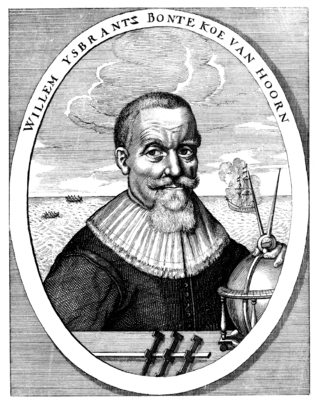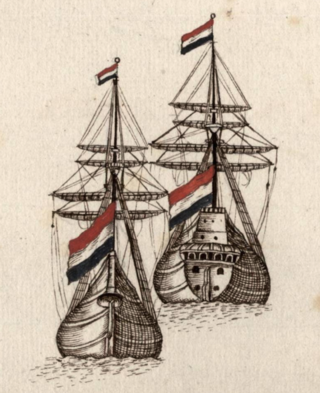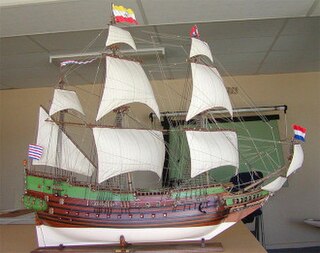
Jacob Le Maire was a Dutch mariner who circumnavigated the Earth in 1615 and 1616. The strait between Tierra del Fuego and Isla de los Estados was named the Le Maire Strait in his honour, though not without controversy. It was Le Maire himself who proposed to the council aboard Eendracht that the new passage should be called by his name and the council unanimously agreed with Le Maire. The author or authors of The Relation took Eendracht captain Willem Schouten's side by proclaiming:

Dirk Hartog was a 17th-century Dutch sailor and explorer. Dirk Hartog's expedition was the second European group to land in Australia and the first to leave behind an artifact to record his visit, the Hartog Plate. His name is sometimes alternatively spelled Dirck Hartog or Dierick Hartochsz. Ernest Giles referred to him as Theodoric Hartog. The Western Australian island Dirk Hartog Island is named after Hartog.

Jan Pieterszoon Coen was a Dutch naval officer of the Dutch East India Company (VOC) in the early 17th century, holding two terms as governor-general of the Dutch East Indies. He was the founder of Batavia, capital of the Dutch East Indies. Renowned for providing the impulse that set the VOC on the path to dominance in the Dutch East Indies, he was long considered a national hero in the Netherlands. Since the 19th century, his legacy has become controversial due to the brutal violence he employed in order to secure a trade monopoly on nutmeg, mace and clove. He led the final Dutch conquest of the Banda Islands in 1621, which culminated in the Banda massacre, which saw 2,800 Bandanese killed and 1,700 enslaved by the Dutch. This is regarded as an act of genocide and earned him the nickname of 'Butcher of Banda'.

Willem Ysbrandtszoon Bontekoe was a skipper in the Dutch East India Company (VOC), who made only one voyage for the company (1618–1625). He became widely known because of the journal of his adventures that was published in 1646 under the title Journael ofte gedenckwaerdige beschrijvinge van de Oost-Indische reyse van Willem Ysbrantsz. Bontekoe van Hoorn, begrijpende veel wonderlijcke en gevaerlijcke saecken hem daer in wedervaren.
The Eendracht was an early 17th century Dutch wooden-hulled 700 tonne East Indiaman, launched in 1615 in the service of the Dutch East India Company (VOC). Its Dutch name means "concord", "unity" or "union", and was a common name given to Dutch ships of the period, from the motto of the Republic: Concordia res parvae crescunt . The ship was captained by Dirk Hartog when he made the second recorded landfall by a European on Australian soil, in 1616.
Ridderschap van Holland was a large retourschip, the largest class of merchantmen built by the Dutch East India Company to trade with the East Indies. In 1694 the ship sailed for Batavia on her fifth voyage, but was never heard from again. She is now thought to have been shipwrecked off the west coast of Australia.
The Vergulde Draeck, also spelled Vergulde Draak and Vergulde Draek, was a 41.8-metre (137 ft), 260-tonne (290-ton) ship constructed in 1653 by the Dutch East India Company. The ship was lost off the coast of western Australia in 1656, with a minority of its crew reaching shore, and only seven subsequently reaching civilization.
Tryall was a British East India Company-owned East Indiaman launched in 1621. She was under the command of John Brooke when she was wrecked on the Tryal Rocks off the north-west coast of Western Australia in 1622. Her crew were the first Englishmen to sight or land on Australia. The wreck is Australia's oldest known shipwreck.
Vianen was a 17th-century Dutch East Indies Company sailing ship, used to transport cargo between Europe and the Indies. She was shipwrecked but refloated on her first voyage, and shipwrecked and sunk on her second. Built at Amsterdam in 1626, she had a gross tonnage of 400.
Fortuyn was a ship owned by the Chamber of Amsterdam of the Dutch East India Company that was lost on its maiden voyage in 1723. It set sail for Batavia from Texel in the Netherlands on 27 September 1723. The ship reached the Cape of Good Hope on 2 January 1724, and continued on its voyage on 18 January. Fortuyn was never seen again and its fate is a matter of speculation.
Aagtekerke was a ship of the Dutch East India Company built in 1724. It was lost without trace during its maiden voyage in 1725–26, sailing from Cape of Good Hope in the Dutch Cape Colony to Batavia in the Dutch East Indies.

Leeuwin, was a Dutch galleon that discovered and mapped some of the southwest corner of Australia in March 1622. It was captained by Jan Fransz and was the seventh European ship to sight the continent.
Thirteen ships of the Dutch East India Company and its pre-companies have been named Amsterdam.
The Concordia was a Dutch sailing ship of the Dutch East India Company that left Batavia on 15 January 1708 with two other vessels, Zuiderburg and Mercurius. Concordia had 130 people on board and was bound for the Cape of Good Hope and then the Netherlands. She was last sighted by Mercurius in open seas to the south of the Sunda Strait on 5 February 1708, in bad weather.

The Mauritius was an early 17th century Dutch wooden-hulled sailing ship, documented as being in service to the Dutch East India Company between 1618 and 1622.
Walter Boyd was the East Indiaman Oosthuizen of the Dutch East India Company. Oosthuizen was launched in 1789 and made one voyage to the Far East. She was on her second voyage in 1794 when the British seized her. In 1795 British interests purchased her and named her Walter Boyd. She made one voyage for the British East India Company. She then became a West Indiaman. On her last voyage, in 1801, Walter Boyd captured a Spanish schooner but then foundered on the way back to London from Martinique.
The Leeuwin was a 400-ton jacht of the Dutch East India Company that travelled to the East Indies twice starting 3 April 1653. It wrecked near Macassar on 24 December 1664.

Heemskerck was the flagship of Abel Janszoon Tasman's exploratory voyage of 1642. She and her consort Zeehaen were the first European ships to explore the south coast of Australia, including Tasmania, cross the Tasman Sea, and reach New Zealand among other achievements.

The Oosterland was a large 17th-century East Indiaman of the Dutch East India Company. The VOC was established in 1602. The ship was wrecked along with another ship by the ship the Kallendijk on 24 May 1695. The shipwreck was discovered by amateur divers in 1988 on the South African coast a few hundred metres from the entrance to Milnerton Lagoon at the mouth of the Salt River. Excavation of the wreck started in the early 1990s in combination with the University of Cape Town and was led by Bruno Werz.
Honkoop, also written as Honcoop or Hencoop, was an 18th-century East Indiaman of the Dutch East India Company. She was a merchant ship that made multiple voyages from Texel, Dutch Republic to Batavia, the Dutch East Indies. The Royal Navy captured her in 1781 during the Battle of Saldanha Bay. In 1782 during a gale, the ship with up to 313 crew members, was lost; she was believed to have foundered with all hands.







